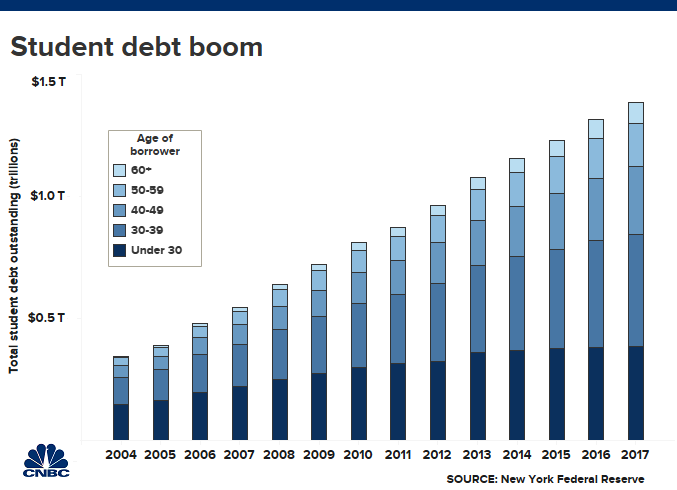
Student debt likely will be a key issue in the 2020 presidential race.
Many of the major contenders for the Democratic nomination, including Sens. Bernie Sanders, Kamala Harris, Sen. Elizabeth Warren and former Vice President Joe Biden, have supported free college and student debt-relief plans.
For example, Sanders' plan would make two- and four-year public colleges and universities tuition- and debt-free. Warren has proposed eliminating the cost of tuition and fees at every public two-year and four-year college and Harris has said she would make community college free and four-year public college debt-free.
A college education is now the second-largest expense an individual is likely to make in a lifetime — right after purchasing a home. Today, the average college graduate leaves school $30,000 in the red, up from $10,000 in the 1990s.

Many states, including Arkansas, Indiana, Minnesota, Montana, Oregon and Rhode Island, have already rolled out statewide free community college programs and more are expected to follow.
As the cost of higher education takes center stage in the political debate, families are also rethinking how best to save for this daunting expense.
"We have this conversation with our clients daily," said Amin Dabit, a certified financial planner and vice president of advisory services for Personal Capital in Denver. "Since we don't know what D.C. will come up with, focus on what you can control."
"Look at your financial situation and come up with a plan to achieve a balance between college savings and retirement savings," he said. "That's the best thing we can do."
More from Personal Finance:
These nine colleges are tuition-free
How families are paying for college
Here's how parents can cut their kids' college costs
When it comes to saving for college, "529 plans are the best vehicle out there," Dabit said.
These state-sponsored savings accounts allow post-tax contributions to grow and be withdrawn tax-free as long as the money is used to pay for qualified education expenses, such as tuition and room and board.
However, there are other options, Dabit said.
With a Roth individual retirement account, for example, savers under age 50 can make after-tax contributions up to $6,000 a year, and then take tax-free withdrawals in retirement. Account holders can also withdraw their contributions at any time — say, to cover college expenses — without taxes or penalties.
It gives you the flexibility to save for retirement and use it for education. It just "blurs the line" between the two, he said.
529 plans are the best option for saving for college.
Mark Kantrowitz
vice president of research at SavingforCollege.com
As it stands, "529 plans are the best option for saving for college," said Mark Kantrowitz, publisher and vice president of research at SavingforCollege.com, echoing Dabit.
Even if every state had a free college program, that would just cover tuition and fees, Kantrowitz said. "It doesn't cover textbooks or room and board."
"Certainly, you can still use that money," he added. (Money left over in a 529 plan can also be used for graduate school, transferred to a sibling or even saved for a grandchild.)
These days only about 10% of families pay for the entire cost of college out of pocket, while everyone else is either borrowing or using a combination of resources, according to Marie O'Malley, senior director of consumer research at Sallie Mae.
In fact, less than half of the cost is covered by income and savings on average, according to Sallie Mae's 12th annual "How America Pays for College" report.
At the same time, participation in 529 plans is growing. The Tax Cut and Jobs Act of 2017 expanded the use of these plans to cover K-12 private school expenses but limited those withdrawals to $10,000 a year per child (there are no limits on withdrawals for college expenses).
The total number of 529 accounts continued to increase from there, reaching 13.6 million in 2018, according to the College Savings Plans Network. This jump occurred as the population under 18 remained fairly flat, according to Pew Charitable Trusts.
In 2018, the average account size also hit an all-time high of $24,153, and total investments in state-sponsored plans reached a record $328.9 billion — an 87% increase from 2010.
Meanwhile, lawmakers have been trying to further expand the uses of 529 plans. Last September, the House Ways and Means Committee passed the Family Savings Act, which would allow college graduates to use 529 plans to cover student debt, but the bill was never passed by the Senate.
0 Comments